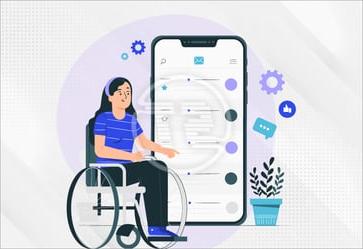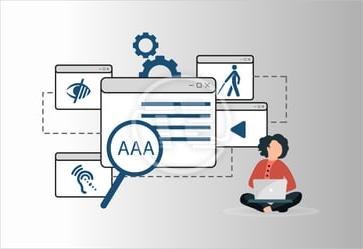Though digital learning is not a new concept, but the post-pandemic need for accessible learning environments has increased. Whether classes are fully online, or in-person with digital components, ensuring digital accessibility is crucial. It allows all students, including those with disabilities, to participate fully in the learning experience.
“It is not beyond our power to create a world in which all children have access to a good education.”
Providing accessible digital educational platforms to each student is possible by using technology and set guidelines (WCAG and other standards). The only requirement for institutions is to embrace accessible mindset and adhere to best web development practices.
Read the article to know the best practices of digital accessibility to help students and teachers with disabilities.
Checklist to create inclusive digital platforms!
Accessible learning platforms
Compatibility with assistive technologies
Learning management systems (LMS) should be compatible with screen readers, voice recognition software, and other assistive technologies.Keyboard navigation
The digital platform’s features should be accessible via keyboard navigation. This includes the ability to navigate menus, submit assignments, and interact with content without using a mouse.Consistent layout
Use a consistent and predictable layout to help students navigate the platform more easily.
Content accessibility
Text alternatives for images and non-text content
Provide alt text for all images, graphs, tables, and other non-text content so that students using screen readers can understand the content.Captions, transcripts, and sign language support
All video and audio content should include captions and transcripts to ensure students with hearing issues can access the educational materials. Additionally, providing sign language support makes digital study material more accessible.
(Please note that third-party widgets such as All in One Accessibility provide sign-language assistance to ensure accessibility for all.)Descriptive links
Hyperlinks should have descriptive text instead of ‘click here’ to give context about where the link will take the user.
Accessible documents
Use accessible document formats
Ensure that all documents (for example: PDFs, Word documents, PowerPoint presentations) are accessible. It means using proper headings, lists, and tables, and avoiding the use of scanned documents that are not readable by screen readers.Provide alternative formats
Offer course materials in multiple formats (for example: text, audio) to cater to different learning needs.Check for color contrast
Ensure there is sufficient color contrast between text and background to make content readable for students with visual impairments.
User-friendly course design
Clear and simple language
Use clear and straightforward language throughout the study material and communications.Consistent navigation
Organize course content in a logical, consistent manner to make it easier for students to find the information they need.Accessible assessments
Ensure that quizzes and tests are accessible, including compatibility with assistive technologies. Also, there must be sufficient time for students to complete the assessments.Usability testing
Despite implementing accessibility throughout the content and web design, accessibility barriers can exist in them. Therefore, usability testing is important. It helps make an educational product user-friendly and more intuitive.
Interactive elements and tools
Accessible discussion boards
Discussion forums and other interactive elements are required to be accessible, and they ought to be navigated using assistive technologies.Inclusive group work
Use collaboration tools that are accessible and ensure all students can participate equally in group projects.Accessible external tools
If an institution is using third-party tools, it is essential to verify that they meet accessibility standards before integrating them into the curriculum.
Ongoing support and feedback
Provide accessibility resources
Make sure students know where to find resources or help if they encounter accessibility issues.Seek feedback
Regularly ask for feedback from students on the accessibility of course materials and be prepared to adjust as needed.Continuous improvement
Stay informed about the latest accessibility standards and best practices to continuously improve the digital learning environment.
Training and Awareness
Educator/teacher training
Provide training to educators on digital accessibility to ensure they understand how to create and deliver accessible content.Awareness campaigns
Conduct awareness campaigns within the institution to promote the importance of digital accessibility among staff and students.
Wrapping up
Providing accessible education is a moral and legal imperative for educational institutions. Inclusive learning environments where every student has equal opportunity to learn, and grow is a basic right of students.
“Making learning fun and accessible for every student in a class requires creative solutions that go beyond after-the-fact retrofitting.”
To acquire such creative and accessible solutions, reach out to a trustworthy web development partner. Skynet Technologies, an associate member of the International Association of Accessibility Professionals (IAAP), offers a range of ADA web accessibility services from design to audit, consulting, training, remediation, and support, we strive to create an inclusive web world. Contact us for a free quote or reach out [email protected].


